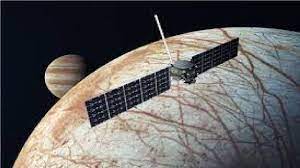
A Beautiful Ringed Planet And It’s Mysterious Moon
With its sparkling frozen retinue of icy moons and moonlets, its gossamer system of rings, and its circling tidbits of glittering ice, Saturn is arguably the loveliest planet in our Sun’s family. As the second-largest planet in our Solar System (after the banded behemoth Jupiter), Saturn orbits our Sun about ten times farther than Earth. However, as enormous as Saturn is, it is so light that it could easily float on water–that is, if a swimming pool exists that is large enough to contain it.
Saturn is a denizen of the cold outer region of our Solar System, along with its giant, majestic, and gaseous planetary siblings: Jupiter, Uranus and Neptune. As the sixth major planet from our Star, Saturn is famous for its large population of attendant moons that, for the most part, are small icy objects. However, Titan, is certainly not small. As the second-largest moon in our Solar System–after Ganymede of Jupiter–Titan is a hydrocarbon tormented, smoggy moon that is a little larger than Mercury, the innermost major planet from our Sun.
Ever since NASA’s Voyager 1 spacecraft soared over Titan back in 1980, astronomers have wanted to peer through its blanket of hydrocarbon fog in order to explore this planet-size-moon’s hidden surface. The now successfully completed Cassini/Huygens voyage to the Saturn-system was a collaborative NASA/European Space Agency/Italian Space Agency mission. The robotic spacecraft was made up of two components. The first was the European Space Agency’s (ESA’s) Huygens Probe, that was named after the Dutch astronomer and mathematician Christiaan Huygens (1629-1695), who discovered Titan. The Huygens Probe also peered at Saturn’s beautiful system of rings and ringlets. The second component, the NASA-designed Cassini Orbiter, was named after the Italian-French astronomer Giovanni Dominico Cassini (1625-1712), who discovered a quartet of Saturn’s other moons.
Following a very dangerous and long voyage through interplanetary space, the Cassini/Huygens Spacecraft arrived at Saturn on July 1, 2004. On December 25, 2004, the Huygens Probe was deliberately severed from the Cassini Orbiter– that had been carrying it piggyback through space–and started its historic dive down through the dense golden clouds to see Titan’s hidden face.
After spending twenty years in operation, Cassini successfully finished its remarkable voyage of exploration and discovery. Cassini’s end came on September 15, 2017, when it approached Saturn for the last time, and was deliberately sent crashing down into the gas-giant’s banded atmosphere by mission scientists. Cassini burned up and disintegrated “like a meteor”, becoming part of the distant planet that it had been observing for so long.
Cassini/Huygens revealed that Titan is a strange world–a fascinating and frigid oddball, with an eerie and haunting resemblance to the primordial Earth before life emerged and evolved on our own planet (prebiotic). Indeed, Titan has the distinction of being the only moon in our Solar System that sports a significant atmosphere. It is also the only known world–other than our own–where stable bodies of liquid pool on its surface.
But there is one significant difference. On Earth, lakes and seas are filled with swirling, sloshing water, while Titan’s lakes and seas contain mostly methane and ethane, that flow within these very exotic reservoirs. In this unearthly cycle, the hydrocarbon molecules evaporate and condense into atmospheric clouds that then pour down a “rain of terror” onto this bizarre moon’s hydrocarbon-tormented surface.
Like Earth, Titan’s atmosphere is mostly composed of nitrogen–with a smaller quantity of methane added to the mix. It is the only other world in our Solar System known to possess a cycle of liquids that shower back down to the surface again–this time in the form of downpours of gasoline. However, even though the ingredients of this exotic witch’s broth are different from those on Earth, this cycle on Titan is similar to our own planet’s water cycle.